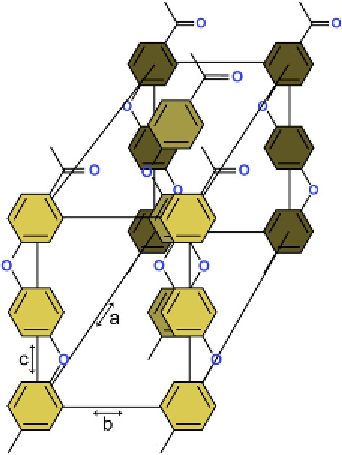Biomedical Engineering Reference
In-Depth Information
Figure 4.2
PEEK unit cell. Polymer chains align with
the
-axis in the orthorhombic structure. Image cour-
tesy of Chris Espinosa, Exponent, Inc.
c
PEEK unit cell dimensions have been reported as
10.0
˚
, resulting in
a crystal density of 1.400 g/cm
3
[2]
. However,
a statistical analysis of the range of observed unit cell
dimensions observed in PEEK confirms that these
dimensions are dependent on crystallization
temperature
[3]
. Defects within the crystal structure
of PEEK, such as mismatch of adjacent chains, might
be expected to occur at low crystallization tempera-
ture, but this is not considered to be the reason for the
observed dependence. Instead, differences in packing
and variations in the angle between the planes of
adjacent phenyl groups are considered to be respon-
sible. The torsional angle corresponds to the tilt of
the aryl group out of the (100) plane and has been
determined to be 40
for PEEK
[3]
.
Unit cell dimensions for PEK have been reported
as
a ¼
7.75
˚
,
b
5.86
˚
, and
c
a
¼
¼
¼
Figure 4.3
Crystallographic pseudo repeat unit for
PEEK (after Hay). Basic repeating structure consists
of two rings. Complete repeating structure in PEEK
requires six rings or two polymer repeat units. Image
courtesy of Chris Espinosa, Exponent, Inc.
4.2.4 Crystallite Morphology
During crystallization, the PAEK polymers align
and fold into lamellae, and except when certain
nucleating fillers are present, the crystalline phase
develops a spherulitic structure. In PEEK, the crystal
unit cell
b
-axis aligns along the radius of the spher-
ulite, whereas the polymer backbone aligns with the
c
-axis and is perpendicular to the long dimension of
the lamellae and the radius of the spherulite. The
preferred growth plane appears to be the (110)
crystallographic plane, which makes an angle of
52.7
the radial
b
-axis
[9]
.
The thickness of lamellae, as well as the size and
density of spherulites, depends on the processing
conditions from the melt
[4,5,8,9,11]
. Typically,
the lamellar thickness of melt-crystallized PEEK is
about 50
e
60
˚
[12]
corresponding to 10
e
12 aryl
groups. At lower crystalline temperatures, crystal
thickness around 20
˚
10.0
˚
, resulting
in a crystal density of 1.430 g/cm
3
[2]
. The similarity
points to the crystallographic equivalence of the ether
and ketone linkages in the PAEK polymers
[10]
.
Despite the similar unit cell, studies on PEK show
that the unit cell dimensions of this polymer do not
follow the same temperature dependence as PEEK
[3]
. This can be interpreted as the result of the
alternating linkages producing a simpler symmetry in
the chains as they crystallize. In PEK, the torsional
angle was determined to be 34
[3]
.
7.63
˚
,
b ¼
5.96
˚
, and
c ¼
(about four aryl groups) has


